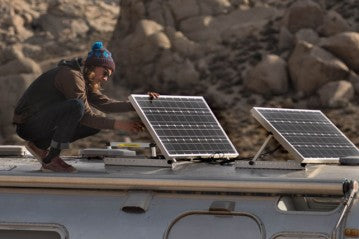
If you own an RV or are considering purchasing one, you may have questions about how to maintain and manage your RV battery. One common concern is whether or not to disconnect the RV battery when it's plugged into a power source. In this article, we'll explore the benefits and drawbacks of leaving your RV battery connected, the charging process when plugged into shore power, the functionality of an RV converter without a battery, and how to use an RV battery disconnect switch effectively.
Is it bad to leave your RV plugged in all the time?
Leaving your RV battery plugged in all the time can have both positive and negative implications. On one hand, keeping the battery connected ensures a continuous supply of power to the RV's systems, such as lighting, appliances, and electronics. This means you won't have to worry about battery drain or power interruptions.
However, constantly leaving the RV battery connected can potentially lead to overcharging, which may damage the battery over time. Overcharging occurs when the battery receives a constant flow of electricity, even when it is already fully charged. To avoid this, some RV owners prefer to disconnect the battery when the RV is not in use or when it's connected to a shore power source for an extended period.
Does the RV battery charge when plugged into shore power?
Yes, when your RV is plugged into shore power, the onboard converter charges the RV battery. The converter converts the incoming AC (alternating current) power from the shore power source into DC (direct current) power, which the RV battery requires for charging and powering the RV's 12-volt systems.
The converter monitors the battery's charge level and automatically adjusts the charging process. When the battery voltage drops below a certain threshold, the converter provides a higher charge to replenish the battery. Once the battery reaches its optimal charge level, the converter switches to a maintenance mode to prevent overcharging. This continuous charging cycle ensures that your RV battery remains charged while connected to shore power.
Will an RV converter work without a battery?
Most modern RV converters require a battery to function properly. The RV converter relies on the battery as a buffer to provide stable and clean DC power to the RV's electrical system. Without a battery, the converter may experience voltage fluctuations and instability, which can lead to damage or malfunction of the RV's appliances and electronics.
However, there are some RV converters equipped with a "battery-less" mode or an "auxiliary power" feature. These converters can operate without a battery by utilizing capacitors or other mechanisms to stabilize the DC power output. If your RV converter supports this feature, you can run your RV's electrical system without a battery, but it's important to consult the converter's manual or contact the manufacturer for specific instructions and limitations.
How to Properly Use an RV Battery Disconnect Switch?
An RV battery disconnect switch is a useful tool to control the power flow to your RV battery. Here are some tips for using it effectively:
1. Familiarize yourself with the switch: Locate the battery disconnect switch in your RV, usually found near the battery or in the RV's electrical compartment. Read the manufacturer's instructions to understand how the switch functions and the different positions it offers.
2. Disconnect when storing or not in use: When storing your RV or if it will remain unused for an extended period, consider disconnecting the battery using the disconnect switch. This prevents parasitic power drain from devices or systems that may draw power even when the RV is not in use.
3. Preserve battery life during storage: If you plan to store your RV for a prolonged period, consider removing the battery and storing it separately. Store the battery in a cool, dry location and keep it charged periodically to prevent self-discharge.
4. Reconnect before using: Before taking your RV out for a trip or using it after a period of storage, make sure to reconnect the battery using the disconnect switch. This will restore power to your RV's systems and ensure a smooth and uninterrupted experience.
When to use an RV battery disconnect?
Knowing when to use the RV battery disconnect switch is crucial for maintaining your battery's health and extending its lifespan. Here are a few instances when using the disconnect switch is beneficial:
1. Long-term storage: If you plan to store your RV for an extended period, such as during the winter season or when you won't be using it for several weeks or months, it's advisable to disconnect the battery using the switch. This prevents unnecessary drain and helps preserve the battery's charge.
2. Maintenance or repairs: When performing maintenance tasks or repairs that involve electrical work in your RV, it's a good practice to disconnect the battery. This ensures your safety and minimizes the risk of electrical accidents or damage to the RV's systems.
3. Battery replacement: If you need to replace your RV battery, disconnecting the old battery using the switch is necessary before installing the new one. This prevents any potential short circuits or accidental damage during the replacement process.
Conclusion
Deciding whether to disconnect your RV battery when it's plugged in depends on your specific circumstances and preferences. While leaving the battery connected ensures uninterrupted power supply to your RV's systems, it can potentially lead to overcharging and battery damage over time. Properly utilizing an RV battery disconnect switch allows you to control the power flow and maintain the battery's health during storage or maintenance periods. Remember to consult your RV's manual and follow manufacturer recommendations for optimal battery maintenance and usage. By adopting these practices, you can enjoy a reliable and long-lasting RV battery that powers your adventures with ease.


0 Kommentare